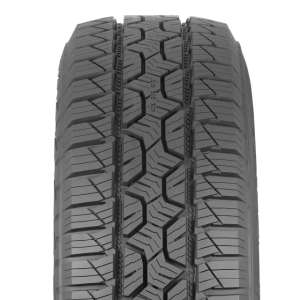Most dedicated winter tires have tight tread blocks and a ton of siping, which isn’t the best approach when you have deeper soapy snow over ice, for example. Slush…that very common winter condition, makes siping irrelevant and most car winter tires are relatively low tread depth so they handle better on dry pavement. A common complaint is that they are terrible in slush.
@tball ’s Hakkas are probably the best example of a more aggressive tire in that class and you stud them to make up for the tradeoff in ice traction. But you can also stud a number of far more aggressive tires.
I note this stuff because I think it is really important to test tires on your vehicle in your conditions. Continental climate winter conditions are very different than maritime, and all ice is not created equal.
My original “wow, all of this FUD about tire type is BS” tire is the Interco Trxus MT. That tire is flat out baller in a continental climate, in part because the tread design has so much lateral traction and also because running a rounded edge tire on a narrowish rim (for the tire width) means you only run on the center section of the tire. You get the hardpack benefit of a narrow tire and the deep benefit of a wide tire that evacuates snow very efficiently.
The downside of the Trxus is that it is almost impossible to balance because it is still made in a clamshell mold and you really can’t keep it from cupping. Enter the Patagonia MT. I kept looking at that tire and I realized “that’s the modern Trxus at a killer price point”. The Patty is also designed to be run only on the center tread, which is this case is smooth and unbroken and provides incredible lateral traction under high torque. It has the perfect amount of dig down to a better surface ratio to forward pull (see my vids above). That doesn’t mean I recommend it, but if you are watching Matt’s Off-road Recovery…this tire is the real deal. If you can spin them enough to generate some heat they get insanely sticky.
Anyway, I’ve always been a fan of taking videos to demonstrate things rather than relying on somebody’s test. This is my 1995 Land Cruiser, lacking any sort of electronic traction control and with a horrendous first gen 3 wheel ABS system, compared to a 2007 Nissan Quest with winter tires and traction control. The Cruiser just has mechanical AWD, center diff is not locked here.
One thing that should jump out as you watch this video is the winter tire with all of its siping doesn’t pull the skiff off the ice. The Trxus does, I have to hammer the throttle to clear it. Slam on the brakes, ABS off, a short easy controlled slide to stop.
Braking distance about the same in these conditions, which are very common in the continental climate winter.
This is particularly informative, I attached a camera to the slider. Watch how the trxus either holds snow or doesn’t as conditions morph from soapy over dirt to road with variable surface conditions. It is doing
exactly what you want in either holding or shedding snow.
The last part of this video is a test I do with all of my tires. That’s a >10% grade downhill, slamming the brakes from 25 mph. Watch how fast it stops and that is a 3 ton pig on 37” tires, 4.5” lift, with no ABS (center diff locked).
Here’s a final two vids of why gearing and lockers and slow speed are king. The first one is that 14% grade carmeggedon hill where I have the Cruiser in low range. I take my foot off the brakes and it walks down that hill at about 1 mph under compression braking. Can’t lock up your brakes if you never need them. The van, by comparison in its lowest gear, runs up to 30 mph. If you have to hit your brakes on that grade, you have a high slide risk.
The second is a good example of what it means for you tire to have an equal design focus on lateral traction and forward. A modern winter tire that relies on traction control (computer braking of slipping wheels) for lateral traction control is dead in the water here. The computer would just shut it down. Those systems are amazing if you are racing on ice tracks, but it’s a knife in a gunfight once your road conditions more resemble off-road conditions.


 . The more capable you are, the worse you get stuck.
. The more capable you are, the worse you get stuck.
